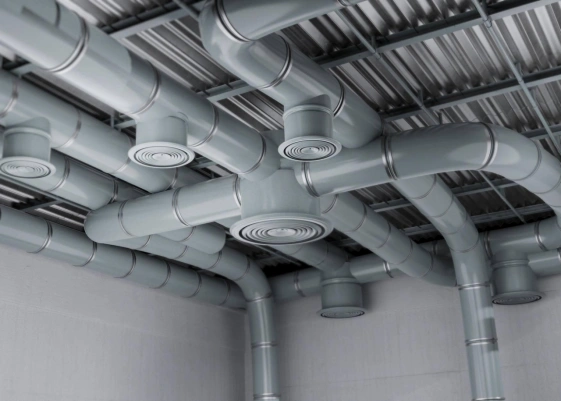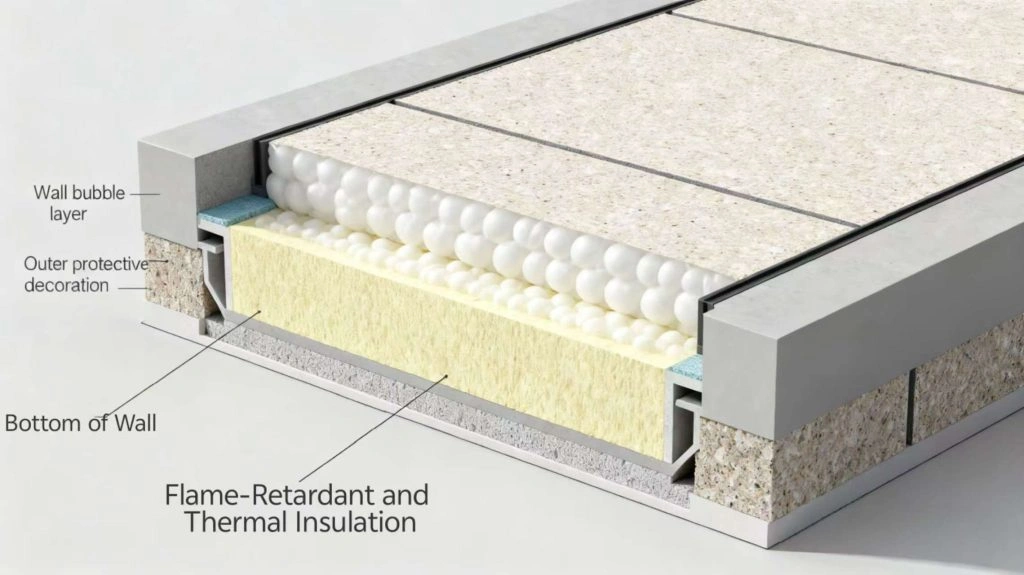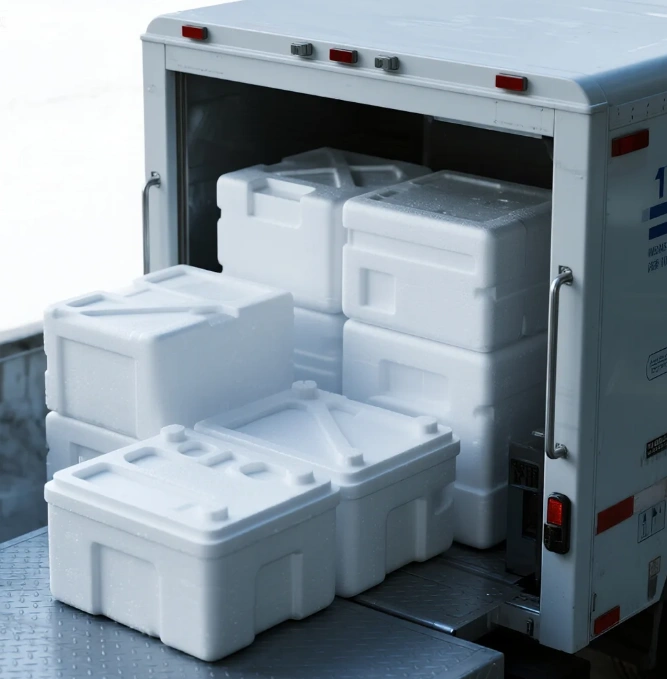In the effort to create green, energy-saving buildings, HVAC (Heating, Ventilation, and Air Conditioning) systems play a big role. Ducts, a key part of these systems, impact how well energy is used. Using EPS (Expanded Polystyrene) molding for HVAC ducts is a smart solution. It saves energy and solves common problems with insulation and installation.

The Role of HVAC Duct Systems in Building Energy Use
HVAC ductwork acts like a building’s air delivery system. It carries heated or cooled air to every room. But poorly built ducts can waste a lot of energy.
Why Thermal Insulation Matters in HVAC Systems
Insulation keeps heat from escaping or entering ducts. Without it, energy is lost, especially in places like attics or basements. Good insulation keeps air at the right temperature. This helps HVAC systems run smoothly. It prevents extra work to fix temperature changes.
Common Causes of Energy Waste in Traditional Ducts
Metal ducts often have loose seals or thermal leaks. These issues cause condensation or heat loss. This makes HVAC systems work harder. Traditional insulation, like fiberglass, can wear out. It may absorb water, which reduces its effectiveness. This increases energy costs over time.
What is EPS Molding and How It Works in HVAC Systems
EPS molding is gaining popularity for making insulated duct parts. Its great thermal properties and flexible design make it a top choice.
Features of Expanded Polystyrene (EPS)
EPS is a lightweight foam made from polystyrene beads expanded with steam. It has tiny closed cells that block heat well. It’s strong, resists water, and is easy to handle. These qualities make it ideal for insulation and duct construction.
EPS Molding Methods for HVAC Duct Parts
EPS molding shapes foam beads into parts using custom molds. Heat and pressure form pieces like elbows, reducers, or straight ducts. These parts have built-in insulation. This removes the need for extra wrapping or covering.
Comparison with Traditional Insulation Materials
Compared to fiberglass or mineral wool, EPS holds its shape better. It’s easier to install. Unlike fibrous materials, EPS doesn’t need protection from water or bugs. It naturally resists these problems, lasting longer with less care.
Key Advantages of EPS Molding in HVAC Duct Systems
EPS-molded ducts offer many benefits. These improve building efficiency and make projects easier.
Better Thermal Performance and Less Heat Loss
EPS has low thermal conductivity, around 0.032 W/m·K. This reduces heat exchange between duct air and the outside. In biopharmaceutical transport, EPS boxes with this conductivity kept temperatures stable for 96 hours. That’s a 40% improvement. The same applies to HVAC ducts, keeping air steady over long distances.
Lightweight Design and Simple Installation
EPS parts are much lighter than metal ducts with added insulation. This makes them easier to carry and install. It reduces strain on ceilings or walls. In automotive uses, high-impact EPS parts (compressive strength 5.2MPa) cut weight by 37%. This saved costs. Similarly, light HVAC parts speed up building projects.
Water Resistance and Tight Seals
EPS doesn’t soak up water, preventing mold in ducts. Its molded joints fit tightly, unlike metal ducts with wrapped insulation. In flood control, hydrophobic EPS modules (water absorption rate <0.5%) were reused 99% of the time. This shows how water resistance extends duct life.
Long-Lasting and Low Maintenance
Unlike fiberglass, which may sag or break down, EPS stays strong. It resists wear from vibrations or exposure. It needs little upkeep or replacement.
Types of EPS Grades Used in HVAC Systems
Different EPS grades meet specific HVAC needs.
Common Grade for Standard Uses
Common Grade EPS is affordable and works well for indoor ducts. It’s great for projects with low fire risk. It provides steady insulation over time.
Flame Retardant Grade for Fire Safety
HUASHENG’s B1 Flame Retardant Grade EPS (density 22kg/m³) meets strict fire codes. It’s safe for commercial or crowded buildings. It keeps strong insulation while ensuring safety.

Graphite Grade for Top Thermal Insulation
Graphite Grade EPS has carbon particles that reflect heat. This lowers thermal conductivity even more. It’s perfect for spaces needing thin but strong insulation.
Grado de protección ambiental para proyectos verdes
For eco-friendly buildings, HUASHENG’s Environmental Protection Grade EPS is 100% recyclable. In EcoPack packaging, it raised ESG scores by 22 points. It supports green goals while meeting standards.
Carbon Black Grade for Outdoor Durability
Carbon Black Grade EPS resists UV damage. It’s ideal for outdoor ducts or vents. It stays strong under sunlight.
Customized REPS for Unique Project Needs
HUASHENG offers Customized REPS (Reinforced Expanded Polystyrene). These are tailored for specific density, shapes, or coatings. They meet unique building demands.
Energy Savings from EPS-Molded HVAC Ducts
EPS ducts improve energy performance in clear ways.
Lower Heating and Cooling Needs
EPS ducts, especially Graphite Grade or Flame Retardant Grade, reduce heat loss. This cuts the energy needed for heating or cooling. It improves system efficiency all year.
Reduced Energy Bills Over Time
Less strain on HVAC systems means lower electricity use. This saves money on bills for homes and businesses. In the GreenBuild Eco-city Project, B1 Flame Retardant Grade EPS saved 14% on energy.
Support for Green Building Certifications (e.g., LEED)
Using HUASHENG’s B1 Flame Retardant Grade EPS helped projects earn LEED Gold Certification. EPS ducts meet energy standards for global sustainability.
Challenges and Considerations for EPS in HVAC Systems
EPS has great benefits, but some factors need attention for large projects.
Strength Under High Pressure
EPS is strong but may need extra support for high-pressure ventilation. Engineers must check load capacity. Customized REPS can help if needed.
Fire Safety Rules and Standards
Some building codes limit flammable materials, even with flame retardants. EPS products must meet EN/ASTM fire standards for approval.
Working with Other Building Systems
EPS ducts must connect well with mechanical, electrical, or plumbing systems. Careful design ensures joints handle vibration or expansion.
HUASHENG: A Reliable Supplier of High-Quality EPS Solutions for HVAC
HUASHENG, based in Lanzhou, specializes in advanced polymer solutions. They provide tailored EPS molding for construction, including insulated HVAC ducts for homes and businesses.
Overview of HUASHENG’s Products and Expertise
HUASHENG offers various EPS grades for specific needs:
Common Grade EPS Products
These budget-friendly options work for indoor ducts with low fire risk. They provide reliable insulation for years.
Flame Retardant Grade for Safety-Critical Projects
HUASHENG’s B1 Flame Retardant Grade EPS, used in GreenBuild Eco-city, saved 14% on energy. It also cut project time by 18 days compared to rock wool.
Graphite Grade for High-Efficiency Needs
Graphite Grade EPS is ideal for spaces needing strong insulation in slim designs. It meets modern building demands.
Environmental Protection Grade for Eco-Friendly Construction
HUASHENG’s 100% recyclable Environmental Protection Grade EPS won the 2024 German iF Design Award for electronics packaging. It supports green construction without losing quality.
Carbon Black Grade for Outdoor Strength
Negro de carbono grado EPS resists UV rays. It’s perfect for rooftop ducts or outdoor vents.
Customized REPS for Specific Client Needs
HUASHENG provides Customized REPS with tailored density (e.g., 22kg/m³) and reinforcements. These meet ISO/EN standards. Visit www.r-eps.com for support with complex designs.

Summary of Benefits of EPS Molding in HVAC Systems
EPS molding improves ductwork for efficiency and sustainability:
- Saves up to 14% on energy.
- Lightweight parts are easy to handle.
- Water resistance prevents mold.
- Durable materials cut long-term costs.
- Flexible grades meet various rules and needs.
From homes to factories, EPS ducts lower costs and improve comfort year-round.
Preguntas frecuentes
Q1: Can molded EPS be used safely in commercial buildings?
A: Yes. HUASHENG’s B1 Flame Retardant Grade meets strict fire safety rules. It’s safe for commercial spaces and insulates well.
Q2: How does Graphite Grade EPS improve energy savings?
A: Graphite particles reflect heat, lowering thermal conductivity. This keeps duct air stable.
Q3: Is there an eco-friendly EPS option?
A: Yes. HUASHENG’s Environmental Protection Grade is 100% recyclable. It supports green buildings without losing quality.






